For: Industrial client
[June – December 2022]
Methanol is a key product in the chemical industry. It is a globally traded base chemical, precursing many other products. It is also used as a fuel or fuel component and it is envisioned as a renewable fuel option, especially for the shipping sector. The interest in renewable, low carbon methanol, both for material and fuel use, is increasing.
A European consortium of industrial partners aims to build a new venture in the area of green methanol that includes the end-customer, to make it possible to pass on the green premium costs via the supply chain. Therefore, they wish to identify potential green methanol end-products, rank them according to market size and interest, and identify potential partners.
studio Gear Up identified opportunities and end-products where the green performance creates value to pay for the additional costs. We developed a long-list of over 50 methanol derived materials and their applications. By far most methanol today is used in the chemical sector, amongst others to produce formaldehyde, olefins and acetic acid. These products in turn are base chemicals for a wide range of further products.

From the long-list, a short-list was derived by considering the methanol content in the final product or the role of methanol in the final service, the significance for the methanol demand, and whether there would (not) be “easier” renewable alternatives than renewable methanol.
Various aspects of the materials and fuels of the shortlist were assessed:
- The impact of using green methanol on the carbon footprint of the end-product
- The impact of the methanol premium costs on the end-product price
- The market size and interest

Depending on the weighting to these impact categories, it seems that fuels and formaldehyde-based materials benefit most from green methanol. Especially, materials from formaldehyde, including pure formaldehyde and polyoxymethylene, deliver great emissions reductions at acceptable prices, and with reasonably large market sizes. Fuel applications, such as FAME, dimethyl ether, and maritime fuel, are performing second-best, either due to their large emissions reductions or their large market and low price impact of green methanol.
Policy makers and policy documents increasingly mention the use of renewable sources to replace fossil resources. Still, there are no policy measures that actively stimulate the production of chemicals and materials from renewable resources. Therefore, the supply of green chemicals is still low, as is the competition in this sector. Nevertheless, business-to-business customers increasingly want to know the carbon footprint of chemical products they purchase, seeing a low carbon footprint as a requirement for their continued ‘license to operate’. We therefore see that the demand pull starts to create some value for materials with lower carbon footprints in the chemicals production sector. In due time, it is expected that the EU will develop legislation to stimulate the use of green resources.
At the same time, the demand for renewable fuels is still increasing and this includes a role for e-fuels like e-methanol. Methanol especially gains interest as a renewable fuel for the shipping sector, and studio Gear Up expects that the demand will sharply increase in the coming years.



